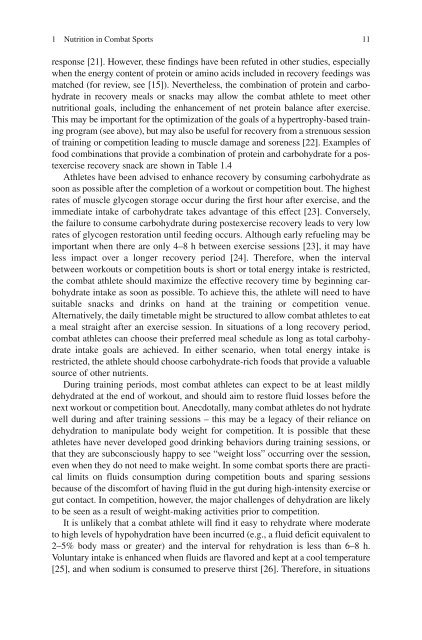Nutrition in Combat Sports
Nutrition in Combat Sports
Nutrition in Combat Sports
You also want an ePaper? Increase the reach of your titles
YUMPU automatically turns print PDFs into web optimized ePapers that Google loves.
1 <strong>Nutrition</strong> <strong>in</strong> <strong>Combat</strong> <strong>Sports</strong> 11<br />
response [21] . However, these f<strong>in</strong>d<strong>in</strong>gs have been refuted <strong>in</strong> other studies, especially<br />
when the energy content of prote<strong>in</strong> or am<strong>in</strong>o acids <strong>in</strong>cluded <strong>in</strong> recovery feed<strong>in</strong>gs was<br />
matched (for review, see [15]). Nevertheless, the comb<strong>in</strong>ation of prote<strong>in</strong> and carbohydrate<br />
<strong>in</strong> recovery meals or snacks may allow the combat athlete to meet other<br />
nutritional goals, <strong>in</strong>clud<strong>in</strong>g the enhancement of net prote<strong>in</strong> balance after exercise.<br />
This may be important for the optimization of the goals of a hypertrophy-based tra<strong>in</strong><strong>in</strong>g<br />
program (see above), but may also be useful for recovery from a strenuous session<br />
of tra<strong>in</strong><strong>in</strong>g or competition lead<strong>in</strong>g to muscle damage and soreness [22] . Examples of<br />
food comb<strong>in</strong>ations that provide a comb<strong>in</strong>ation of prote<strong>in</strong> and carbohydrate for a postexercise<br />
recovery snack are shown <strong>in</strong> Table 1.4<br />
Athletes have been advised to enhance recovery by consum<strong>in</strong>g carbohydrate as<br />
soon as possible after the completion of a workout or competition bout. The highest<br />
rates of muscle glycogen storage occur dur<strong>in</strong>g the first hour after exercise, and the<br />
immediate <strong>in</strong>take of carbohydrate takes advantage of this effect [23] . Conversely,<br />
the failure to consume carbohydrate dur<strong>in</strong>g postexercise recovery leads to very low<br />
rates of glycogen restoration until feed<strong>in</strong>g occurs. Although early refuel<strong>in</strong>g may be<br />
important when there are only 4–8 h between exercise sessions [23] , it may have<br />
less impact over a longer recovery period [24] . Therefore, when the <strong>in</strong>terval<br />
between workouts or competition bouts is short or total energy <strong>in</strong>take is restricted,<br />
the combat athlete should maximize the effective recovery time by beg<strong>in</strong>n<strong>in</strong>g carbohydrate<br />
<strong>in</strong>take as soon as possible. To achieve this, the athlete will need to have<br />
suitable snacks and dr<strong>in</strong>ks on hand at the tra<strong>in</strong><strong>in</strong>g or competition venue.<br />
Alternatively, the daily timetable might be structured to allow combat athletes to eat<br />
a meal straight after an exercise session. In situations of a long recovery period,<br />
combat athletes can choose their preferred meal schedule as long as total carbohydrate<br />
<strong>in</strong>take goals are achieved. In either scenario, when total energy <strong>in</strong>take is<br />
restricted, the athlete should choose carbohydrate-rich foods that provide a valuable<br />
source of other nutrients.<br />
Dur<strong>in</strong>g tra<strong>in</strong><strong>in</strong>g periods, most combat athletes can expect to be at least mildly<br />
dehydrated at the end of workout, and should aim to restore fluid losses before the<br />
next workout or competition bout. Anecdotally, many combat athletes do not hydrate<br />
well dur<strong>in</strong>g and after tra<strong>in</strong><strong>in</strong>g sessions – this may be a legacy of their reliance on<br />
dehydration to manipulate body weight for competition. It is possible that these<br />
athletes have never developed good dr<strong>in</strong>k<strong>in</strong>g behaviors dur<strong>in</strong>g tra<strong>in</strong><strong>in</strong>g sessions, or<br />
that they are subconsciously happy to see “weight loss” occurr<strong>in</strong>g over the session,<br />
even when they do not need to make weight. In some combat sports there are practical<br />
limits on fluids consumption dur<strong>in</strong>g competition bouts and spar<strong>in</strong>g sessions<br />
because of the discomfort of hav<strong>in</strong>g fluid <strong>in</strong> the gut dur<strong>in</strong>g high-<strong>in</strong>tensity exercise or<br />
gut contact. In competition, however, the major challenges of dehydration are likely<br />
to be seen as a result of weight-mak<strong>in</strong>g activities prior to competition.<br />
It is unlikely that a combat athlete will f<strong>in</strong>d it easy to rehydrate where moderate<br />
to high levels of hypohydration have been <strong>in</strong>curred (e.g., a fluid deficit equivalent to<br />
2–5% body mass or greater) and the <strong>in</strong>terval for rehydration is less than 6–8 h.<br />
Voluntary <strong>in</strong>take is enhanced when fluids are flavored and kept at a cool temperature<br />
[25] , and when sodium is consumed to preserve thirst [26] . Therefore, <strong>in</strong> situations

















